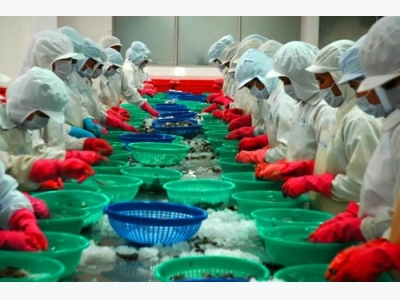Shrimp exporters told to improve methods

If the shrimp industry does not change it will be unable to export and will also need to be rescued like its pork, dragon fruit and watermelon counterparts. — Photo cafef
HCM CITY — If the shrimp industry does not change it will be unable to export and will also need to be rescued like its pork, dragon fruit and watermelon counterparts, a seminar on establishing a disease-free shrimp production chain for export heard in HCM City on July 5.
Phạm Văn Đông, head of the Department of Animal Health, said earnings from shrimp exports have increased significantly in recent years, but the industry faces many challenges in breeding due to the impact of climate changes and diseases.
Companies have also faced difficulties in exports due to the increasingly strict technical barriers related to diseases and antibiotic residues put up by importing countries, he said.
Recently six markets -- Australia, South Korea, Saudi Arabia, China, Brazil, and Mexico -- have said they would buy only products with disease-free certification in accordance with World Organisation for Animal Health regulations or recognised as free of diseases by their authorised agencies.
These markets account for 25 per cent of the country’s total shrimp exports, or equivalent to US$800 million a year.
Trương Đình Hòe, general secretary of the Việt Nam Association of Seafood Exporters and Producers, said shrimp processors and exporters are deeply worried about the disease-free certification requirement.
It is hard for them to meet the demand in a short time, he said.
With the small average scale of production, if the country does not have comprehensive national measures, exporters would face difficulties in exporting in future.
Đặng Quốc Tuấn, deputy general director of Việt Nam-Australia Seafood Corporation (Việt-Úc Seafood), said the survival rate of shrimp in Việt Nam is very low at just 25-30 per cent due to the low professional level of farmers. Vietnamese shrimp mainly competes on price, and the new regulations mean they cannot be exported whatever their price, he said.
The industry would therefore be forced to change, he said.
Nguyễn Văn Long, head of the department’s seafood veterinary division, said the department has a programme to enable firms to meet regulations set by importing countries since 2014, but enterprises remain unmindful of this.
Only Việt-Úc Seafood and Huy Long An Company have participated in the programme to develop disease-free shrimp breeding facilities.
Việt-Úc Seafood has basically met the criteria to be recognised by animal health department.
Farmers and businesses in the country are generally not aware of the importance of building disease-free shrimp breeding facilities.
But if the industry persists with its current production methods, it would need to be rescued sooner rather than later.
Related news
Tools

Phối trộn thức ăn chăn nuôi

Pha dung dịch thủy canh

Định mức cho tôm ăn

Phối trộn phân bón NPK

Xác định tỷ lệ tôm sống

Chuyển đổi đơn vị phân bón

Xác định công suất sục khí

Chuyển đổi đơn vị tôm

Tính diện tích nhà kính

Tính thể tích ao



 Vietnam targets 10 billion USD in shrimp exports…
Vietnam targets 10 billion USD in shrimp exports…  Japan rules a hurdle for Vietnam seafood
Japan rules a hurdle for Vietnam seafood